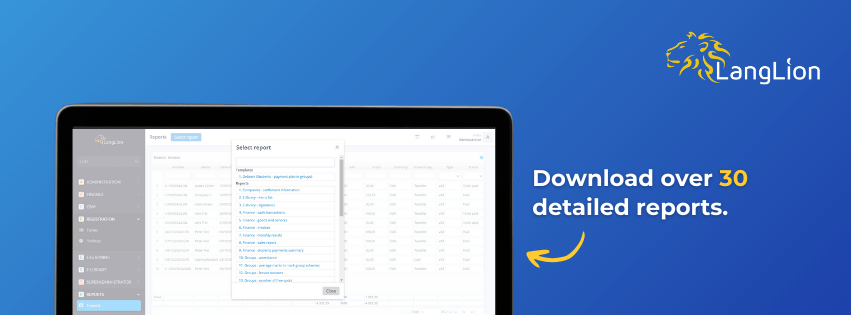
The language school market is developing dynamically, and competition in the industry is growing. To ensure your school succeeds, having a good offer is not enough – it’s essential to monitor the right indicators that will help you assess the effectiveness of your actions and optimize your business strategy. In this article, we will discuss 6 key performance indicators (KPIs) that every language school should track to increase its profitability and reach students more effectively.
What will you find in this article?
- Business performance indicators for language schools
- 6 performance indicators for a language school
- How to facilitate measuring KPIs?
- Summary – performance indicators for a language school
Language school business performance indicators
The language school market is more competitive today than ever before. Competition is increasing, and customers have more choices. Therefore, it’s not enough to just teach well – you also need to effectively manage the school as a business.
Every language school owner loves education and wants to share their passion for language learning, but they must also ensure profitability and growth of their business.
Sometimes, a simple spreadsheet is enough to better understand the direction the school is heading and what to focus on. Key Performance Indicators (KPIs) allow you to monitor the financial health of the company, the effectiveness of marketing activities, and the level of student satisfaction.
Below, we present 6 performance indicators for language schools that will help you make better decisions and grow the business in a stable, well-thought-out way.
6 performance indicators for a language school
1. Customer retention rate – keep students longer
Student loyalty is the foundation of a stable business. It’s easier to retain an existing customer than to constantly acquire new students, so it’s worth focusing on activities that increase the retention rate.
How to calculate it?
(Number of students who extended their course / Total number of students) × 100%
What to do to increase the retention rate?
- Effective communication with students and parents (if you teach children).
- Loyalty programs and discounts for regular customers.
- Satisfaction monitoring – surveys, nps, interviews, collecting opinions.
- Diverse teaching methods and course personalization.
- Referral programs that offer discounts.
Important: according to Nielsen research, as much as 83% of consumers trust recommendations from friends more than advertisements. A satisfied student is the best form of promotion for your school!
2. Website traffic and social media
Your language school must be visible online – potential students look for information on the internet and social media. If you’re not reaching them online, you’re losing clients to competitors.
How to track this metric?
- Analyze the number of website visits and conversion rate.
- Check reach and engagement on social media (Facebook, Instagram, TikTok, LinkedIn).
How to increase traffic?
- Start managing your language school’s social media wisely.
- Create a content marketing strategy for your school.
- Run a blog with valuable content.
- Utilize video (vertical formats work excellently on social media).
- Ensure effective SEO for your language school.
- Invest in advertising (for example, Google Ads or Facebook Ads).
- Set up Google Business Profile for language school.
3. Profit margin per student – are your courses profitable?
Having a lot of students isn’t enough – what’s important is whether your courses generate adequate profits. The profit margin per student helps determine the profitability of individual courses. On the other hand, an analysis of course profitability will show you which areas of your operations are the most beneficial and which require changes.
How to calculate it?
(Course Revenue – Course Costs) / Number of Students
How to improve profitability?
- Work on your pricing by adjusting prices to the value you offer.
- Offer premium courses (e.g., annual sale of a limited number of spots in highly specialized classes).
- Reduce unnecessary operational costs (e.g., optimize room rentals).
4. New enrollments, meaning new students in your school
A regular influx of new students is essential for the growth of the school. It’s crucial to monitor the number of enrollments and analyze the effectiveness of marketing efforts.
How to analyze this indicator?
- Check the number of new enrollments in a given period.
- Measure where students come from – are they referrals, advertisements, or social media?
- Compare the number of inquiries about courses to the actual number of enrollments.
How to increase enrollments?
- Optimize the registration process – forms must be simple, clear, and quick.
- Use remarketing to reach people who visited the site but did not enroll. – Promote courses in neighborhood groups, local communities, and forums.
5. Diverse course offerings – meeting market needs
Currently, students are looking for individualized and tailored teaching programs. Schools that offer only standard courses are losing clients to more flexible institutions.
How to increase the attractiveness of your offer?
- Introduce specialized courses – for example: Business English, Legal English, etc.
- Provide flexible learning formats – online, hybrid, intensive courses.
- Offer corporate and institutional courses – a significant growth potential!
- Introduce language mentoring options, where students receive individual support.
Example: schools that incorporate gamification (learning through games) into language courses for children not only attract more clients but also make lessons more dynamic and engaging, which supports more effective material retention.
6. Website inquiries – does your site encourage contact?
A good language school website is not just its business card but a tool for generating enrollments. If website visitors are not filling out contact forms, it means something is not working.
How to analyze this indicator?
- Check the number of site visits in relation to the number of inquiries.
- Test different CTAs („Sign up for a trial lesson,” „Download a free e-book”).
- Improve the website’s UX: the sign-up form should be visible and understandable, and navigation should be intuitive.
How to facilitate measuring KPIs?
If you are already measuring and analyzing various indicators, you are probably using a language school management system.
The LangLion Platform, which is dedicated exclusively to language schools, not only streamlines daily operations but also enables data compilation over a selected period through the „Reports” module.
This tool allows for easier monitoring of key indicators and making accurate business decisions. It supports language school management. Over 30 personalized reports enable the analysis of teaching results, attendance, and financial aspects. Thanks to this, school owners can make informed decisions and effectively plan further development.

Summary – performance indicators for a language school
The success of a language school depends on many elements, including the analysis of key indicators and adapting strategies to current trends. Regularly monitoring customer retention, website traffic, course profitability, and new enrollments will help you grow your business and effectively increase revenue.
If you have doubts about the actions your school needs, we are happy to advise you! Request a free demo of LangLion!
